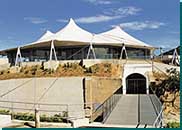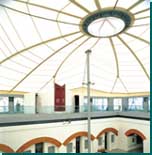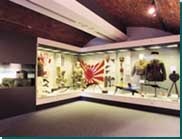| August
2000 |


|
|
|
Museum of Coastal Defence
Fortified
heritage
About seven years ago
the Architectural Services Department (ArchSD) was approached by
two Urban Councillors about the development of a musuem for some
Hong Kong Voluntary Defence Corp (VDC) artefacts. The VDC was to
be disbanded in 1995, ahead of the handover in 1997. Would the ArchSD
investigate how the artefacts could best be stored and where?
 An
old barracks at Lei Yue Mun had been identified as a possible site
and, in response to the request, ArchSD commissioned Dr Solomon
Bard, the first head of the Antiquities & Monuments Office,
to prepare a guide for storing the artefacts. An
old barracks at Lei Yue Mun had been identified as a possible site
and, in response to the request, ArchSD commissioned Dr Solomon
Bard, the first head of the Antiquities & Monuments Office,
to prepare a guide for storing the artefacts.
Then an unexpected discovery
transformed what was originally a humble idea into something grander
and more meaningful.
While
inspecting the elevated site near Heng Fa Chuen, the department
found a 19th century redoubt containing a network of underground
chambers. Built by the British in 1887 to defend its interests against
the hawkish French and Russians, it was also the site of a fierce
World War II battle between the British, Canadian and Indian soldiers
entrusted with the task of defending Hong Kong and 20,000 Japanese
soldiers who crossed the Gin Drinker's Line into the territory.
The site had been used
as a holiday camp since it was handed over to the Urban Council
in 1987 but was otherwise closed to the public. The Civil Aviation
Department and Hong Kong Observatory also had equipment set up there
to collect data on aircraft movements and the weather. Being under
the flight path of the old airport, the site was also subject to
civil aviation height restrictions. Despite these constraints on
development, the potential of the site, with its history as well
as spectacular seaview and greenery, was simply too great to be
ignored.
"We wondered whether
putting the artefacts on display there would attract visitors. The
redoubt itself and its location were very attractive, so we submitted
a proposal to the Urban Council for developing a museum," recalled
ArchSD architect Kenneth Tam.
The Urban Council liked
the idea, but had reservations about the lack of utilities and space
for the modern facility it wanted.
This was not the only
challenge faced by the architect.
Designed as a defence
position overlooking the narrow channel and shielded by thick vegetation,
the redoubt was never meant to be easily accessible to others. However,
if it was to be turned into a museum, the architect had to find
a way to improve access without destroying the original character
of the site with its fine example of Victorian fortification. Then
there was the need to bring water and electricity there to make
the museum concept feasible and a demand by the Fire Services Department
for the provision of emergency road access.
Seeking guidance from
similar projects, a team comprising Mr Tam, the two Urban Councillors,
the museum curator and an antiquity manager went to North America
to study other defence museums. They visited the Queen Beatrice
Museum in Calgary, the Citadel in Halifax, the West Point Military
Academy and the War Museum in Ottawa. It was at Halifax that they
saw a restored redoubt where the British and French had battled
for control of North America in the 19th century. At the War Museum
in Ottawa, they walked into a room showing the Battle of Hong Kong.
To think a war museum
in Canada should have a record of such an important part of Hong
Kong's history while Hong Kong itself had none!
That strengthened the
visitors' resolve to develop the Museum of Coastal Defence, to preserve
a piece of Hong Kong history for posterity. With the support of
the Antiquities Advisory Board, the department began to develop
its ideas in greater detail.
Apart from a large courtyard
and various tunnels and passages, the 1,600 sq m redoubt has more
than ten underground casemates which were originally used as the
soldiers' quarters, kitchen and ammunition store. It was subjected
to ten days of heavy bombardment by the Japanese during the war,
an episode in its history to which the many bullet holes can testify.
However, although it was damaged, the redoubt was still structurally
sound, so a decision was taken to preserve it and convert it into
a museum.
Tension structure
To develop a permanent, self-contained museum with air-conditioning
and state-of-the-art temperature control, the architect decided
to enclose the area with a tension structure. According to Mr Tam,
the decision was influenced by two factors.
"We wanted a material
which would allow the site to be restored to its original condition.
A tension structure would allow for preservation of the artefacts
in an optimum environment with minimum interference with the site.
Tents also invoke military associations," he explained.
The tension structure
is supported by 100 mini piles driven to a depth of 14 m at carefully
chosen spots around the historical site. To ensure that it would
be strong enough to withstand typhoons, a mock-up was taken through
wind tunnel tests in Germany before a permit was issued for its
erection. According to Mr Tam, since the Chek Lap Kok airport project
was not yet confirmed at the time the museum was being designed,
a lower tension structure was developed to ensure it complied with
civil aviation height restrictions.
The structure, which
was computer-designed by a specialist, has a lifespan of 25 years.
Recent experiments have indicated that it will remain robust up
to the end of its designed life.
According to Mr Tam,
the structure will provide a unique experience for visitors as it
will actually shift in the wind. However, this fact also proves
a design challenge as it is not intended to be a free-moving structure,
but is fixed to glass walls to form a fully enclosed environment.
The underground casemates,
which used to accommodate approximately 100 soldiers and other facilities,
have been converted into exhibition rooms, offices and an audio-visual
theatre offering information on Hong Kong's coastal defence over
the last 600 years.
 Historical
ammunition Historical
ammunition
Apart from the redoubt, the 6,200 sq m site also includes other
military installations of great interest. These include the emplacements
of two disppearing guns, a torpedo station, a central battery, an
underground magazine and a caponier which guards the ditch in the
southeast corner of the barracks. These have all been restored and
organised into an historical trail which also takes in the ruin
of the blacksmith's house, the remains of which nature has claimed
as its own, with a tree flourishing within and above the original
brick chimney.
Although the original
guns in the emplacements have been replaced by replicas, visitors
can still see the mechanical device once used to raise the guns
to the surface for firing before being retracted to foil enemy detection.
Another feature is a
torpedo station which was built inside an original cave. This is
no ordinary torpedo station. The torpedoes once fired across the
narrow channel, invented by the Australian, Joseph Brennan, could
be remotely guided and winched back after being fired, for the next
attack on hostile shipping. This is one of just two Brennan torpedo
stations in the world. The other example is in Australia, and there
is a model in the UK.
There is a battery where
bullet holes in the crumbling brick wall, at the height of an average
person's head, suggested it might have been used for executions
in the past. The brick wall has been repaired using bricks from
the demolished mental hospital in Sai Ying Pun, another 19th century
structure, and the battery is now used to exhibit a range of period
cannons.
Among all these historical
features, there was one which could not be displayed - unexploded
ordnance. To make the site safe, Mr Tam said a team of retired Gurkhas
was hired to comb through the soil by hand, often going as far as
4 m down, to uncover old bombs. Most of the bombs discovered were
outgoing shells the British army didn't use, which posed relatively
less risk; and not incoming shells that failed to go off. Nevertheless,
the Gurkhas did discover 26 bombs which required controlled explosions.
New structures
In order to improve the accessibility and attractiveness of the
museum, new structures and facilities were added. The most important
of these is a lift tower which was built at the entry point to the
park which provides access via the Island Eastern Corridor and is
served by a small car park providing dropoff for coaches and shuttle
buses.
The lift tower contains
two lifts, a display room, a reception and toilets. A model of the
museum has been sunk into the floor of the entrance to help with
visitor orientation. The tower stands like a monolith in the midst
of the green strip lining the Shau Kei Wan shore. It is clad in
plain concrete, intended to reflect the simplicity of a military
installation, and features a deliberately compact design which minimised
the need to remove vegetation from site.
In addition to visitor
transport, the lift tower is also used to channel cables and pipelines
to the redoubt, thus minimising excavation work.
The lift tower leads
to a footbridge which replaces the original retractable bridge leading
to the redoubt. Used for carrying utilities to site, the footbridge
is fitted with glass parapets designed to open up the view for visitors.
Near the museum end of
the footbridge, a viewing platform has been created to take advantage
of the panoramic view. Another new structure is a new cafe block
which has been constructed in an open courtyard to the east of the
site, to provide refreshments to visitors.
The HK$273 million project,
which was constructed by Leighton Asia, is believed to be one of
the largest fort restoration projects in the world.
|

 An
old barracks at Lei Yue Mun had been identified as a possible site
and, in response to the request, ArchSD commissioned Dr Solomon
Bard, the first head of the Antiquities & Monuments Office,
to prepare a guide for storing the artefacts.
An
old barracks at Lei Yue Mun had been identified as a possible site
and, in response to the request, ArchSD commissioned Dr Solomon
Bard, the first head of the Antiquities & Monuments Office,
to prepare a guide for storing the artefacts. Historical
ammunition
Historical
ammunition